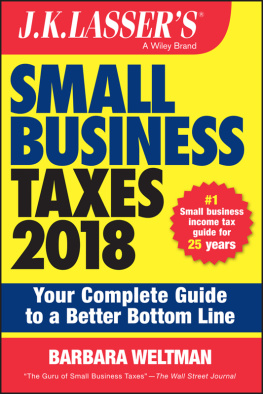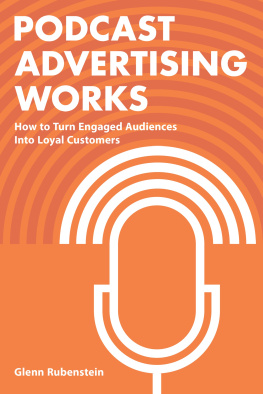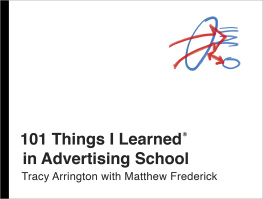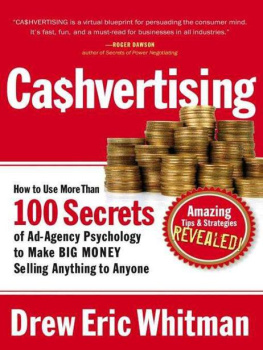Seducing Strangers
How to Get People to Buy What Youre Selling
{ The Little Black Book of Advertising Secrets }
Josh Weltman
Workman Publishing
New York
For Angela
Contents
Foreword by Jon Hamm
Josh Weltman is the unsung hero of Mad Men. Beyond the clothes, the women, the booze and cigarettes, Josh provides our world with a credible foundation in an industry that exists, almost by definition, in an incredible, or at least hyperbolic, state.
Don Draper is actually good at his job because Josh is actually good at his. Joshs former career and wealth of experience as an actual creative director making actual campaigns to sell actual things has brought authenticity, depth, and resonance to this character who thinks and creates for a living. This contribution has been invaluable to the whole of the character and to the story.
People often ask me questions or ask my opinions on or about the world of advertising. My stock response is You know I play a fictional advertising executive, right? Thats usually used to cover the ignorance or stupidity of whatever I am about to say next. In the future, I will simply refer them to Josh.
Introduction
The Job That Was Once Called Advertising
The job was using words, pictures, stories, and music to make someone somewhere do something. In the industrial, mass-media, consumer economy of the past, the job was called advertising, and Mad men did it. In our modern, service-based, social-media-centric information economy, the job is called life, and everybody does it.
Once it was the job of these advertising executives on Madison AvenueMad mento be the public champions of products and services, making businesses successful and customers happy. Don Draper always seemed to know exactly how to do it. He knew what the business goal of the advertising was. He knew how to create an insightful, persuasive message. And he had teams of experts to help him decide which media would help him do the job best.
In todays information economy, the power to persuade remains the coin of the realm. But persuasion is no longer the job of just a creative director and a host of media buyers. Today its everyones job. People working in todays information economy spend all or most of their time and effort trying to get someone somewhere to do something. From the CEO of a multinational company trying to establish a presence on Facebook to a teenager tweeting about a pair of awesome-looking jeans, everyone needs to be able to effectively persuade someone, whether its a boss or a boyfriend, a customer or a committee.
The problem is that most people today dont feel equipped to craft messages or take action with the same confidence and certainty as Mad Mens Don Draper. Two things confound them. First, most are a lot less familiar with the principles of persuasion than they are with the means. Theyre not quite sure what makes a message persuasive, but they know how to use a smartphone to tweet 140 characters to millions of people in a second. Second, recent and rapid changes in new digital media technology make doing the job hardeven for experts who do understand the principles of persuasion. Why? Because today there are more ways to go about it than ever. Changes in media affect how we figure out the somewhere part of the job. And with all the hype, hysteria, big money, high-tech IPOs, consolidation, disruption, and destruction that is the digital media revolution, people who are trying to get someone somewhere to do something can lose sight of the get someone and the do something part of the job.
Lee Clow is president and chief creative officer of TBWA/ Media Arts Lab. The man behind acclaimed multimedia ad campaigns for Apple, Nissan, Energizer Battery, and Pedigree Petfoods, among others, Clow is arguably the most famous and acclaimed creative director ever. This is what he said recently when asked about the current state of advertising:
We havent come close to figuring out how to use all these new-media opportunities, and most clients are very conflicted about what media they should use, why, and how. They keep thinking theres some new silver bullet in the new-media world that will allow them to save money or find a new way to twist consumers arms.
This book establishes some new communications principles to help you come up with more effective, persuasive ideas and understand where to place them in a world of changing technology and changing consumer expectations.
I never would have written this book if I had not been hired to be an advertising consultant on Mad Men. My job was to see that the show accurately depicted the process of creating ads and servicing clients. I didnt know what I knew about advertising or how I did it until I needed to explain it to Mad Men creator Matt Weiner and the shows writing and production staff.
In the writers room, Matt would constantly ask me and Bob Levinson, the shows other advertising consultant, What would they do in this situation? Weiner and the other writers were trying to make drama, not advertising. He wasnt interested in what was going through Dons head when Don stared out the window. He was interested only in what could be seen, said, and dramatized and how it made the story better, more intriguing or surprising.
Seven years spent thinking about how to depict the process of persuasion made me think deeply about what I do to create and sell ideas that connect with and motivate other people. It made me think a lot about what is principle and what is fashion. What was it about getting someone somewhere to do something that would have been as true in the midcentury Mad Men world of Madison Avenue as it is today? And what ideas about advertising were just 1960s style?
Today every Starbucks I walk into looks like every creative department Ive ever been in. People are writing, creating presentations, blogging, and trying to think of ideas to tweet, email, or post in order to persuade someone somewhere to do something. My aim here is to offer some proven techniques that have helped me do the same thingsfaster, better, and more confidently.
The goal of this book is to explain how messages that make people do things work. And its written for anyone expected to make something happen by using words, pictures, stories, or music.
To help me understand a clients goals, I often ask, Its a year from now, and weve all come back into this conference room to celebrate the success of this ad campaign weve created. Tell me, what are we celebrating? What did we do? What happened? How did we know when it was time to stop working and open a bottle of Champagne?
A year from now, I want to walk into a Starbucks and see someone sitting at a table with a computer and a couple of books. One is a Moleskine notebook. Its filled with ideas, sketches, headlines, scraps of paper, bits and pieces. The other is a copy of this book. Its dog-eared and worn. The spine is cracked. Passages are underlined, and bookmarks are sticking out all over it. And the person sitting at that table with his laptop and books has that Please dont talk to me. I need to get this idea down before I lose it look.
When I see that, Ill know Ive done my job, and Ill open a bottle of Champagne.
This book is for anyone expected to make something happen by using words, pictures, stories, or music.
Part One
The Secret Purpose of Advertising
When I get asked...Whats the secret to success? I just say: Early to bed, early to rise, work like hell, and advertise.








